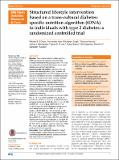| dc.contributor.author | Chee, Winnie S S | en_US |
| dc.contributor.author | Gilcharan Singh, Harvinder Kaur | en_US |
| dc.contributor.author | Hamdy, Osama | en_US |
| dc.contributor.author | Mechanick, Jeffrey I | en_US |
| dc.contributor.author | Lee, Verna K M | en_US |
| dc.contributor.author | Barua, Ankur | en_US |
| dc.contributor.author | Mohd Ali, Siti Zubaidah | en_US |
| dc.contributor.author | Hussein, Zanariah | en_US |
| dc.date.accessioned | 2018-03-20T16:01:12Z | |
| dc.date.issued | 2017 | en_US |
| dc.identifier.citation | Chee, Winnie S S, Harvinder Kaur Gilcharan Singh, Osama Hamdy, Jeffrey I Mechanick, Verna K M Lee, Ankur Barua, Siti Zubaidah Mohd Ali, and Zanariah Hussein. 2017. “Structured lifestyle intervention based on a trans-cultural diabetes-specific nutrition algorithm (tDNA) in individuals with type 2 diabetes: a randomized controlled trial.” BMJ Open Diabetes Research & Care 5 (1): e000384. doi:10.1136/bmjdrc-2016-000384. http://dx.doi.org/10.1136/bmjdrc-2016-000384. | en |
| dc.identifier.issn | | en |
| dc.identifier.uri | http://nrs.harvard.edu/urn-3:HUL.InstRepos:35014843 | |
| dc.description.abstract | Objective: Trans-cultural diabetes nutrition algorithm (tDNA) was created by international task force and culturally customized for Malaysian population. This study was designed to evaluate its effectiveness versus usual diabetes care in primary care settings. Research design and methods We randomized 230 patients with overweight/obesity, type 2 diabetes, and glycated hemoglobin (A1c) 7%–11% to receive usual care (UC) or UC with tDNA for 6 months. The tDNA intervention consisted of structured low-calorie meal plan, diabetes-specific meal replacements, and increased physical activity. Participants were counseled either through motivational interviewing (tDNA-MI) or conventional counseling (tDNA-CC). The UC group received standard dietary and exercise advice through conventional counseling. All patients were followed for another 6 months after intervention. Results: At 6 months, A1c decreased significantly in tDNA-MI (−1.1±0.1%, p<0.001) and tDNA-CC (−0.5±0.1%, p=0.001) but not in UC (−0.2±0.1%, p=NS). Body weight decreased significantly in tDNA-MI (−6.9±1.3 kg, p<0.001) and tDNA-CC (−5.3±1.2 kg, p<0.001) but not in UC (−0.8±0.5 kg, p=NS). tDNA-MI patients had significantly lower fasting plasma glucose (tDNA-MI: −1.1±0.3 mmol/L, p<0.001; tDNA-CC: −0.6±0.3 mmol/L, p=NS; UC: 0.1±0.3 mmol/L, p=NS) and systolic blood pressure (tDNA-MI: −9±2 mm Hg, p<0.001; tDNA-CC: −9±2 mm Hg, p=0.001; UC: −1±2 mm Hg, p=NS). At 1 year, tDNA-MI patients maintained significant reduction in A1c (tDNA-MI: −0.5±0.2%, p=0.006 vs tDNA-CC: 0.1±0.2%, p=NS and UC: 0.02±0.01%, p=NS) and significant weight loss (tDNA-MI: −5.8±1.3 kg, p<0.001 vs tDNA-CC: −3.3±1.2 kg, p=NS and UC: 0.5±0.6 kg, p=NS). Conclusions: Structured lifestyle intervention through culturally adapted nutrition algorithm and motivational interviewing significantly improved diabetes control and body weight in primary care setting. | en |
| dc.language.iso | en_US | en |
| dc.publisher | BMJ Publishing Group | en |
| dc.relation.isversionof | doi:10.1136/bmjdrc-2016-000384 | en |
| dc.relation.hasversion | http://www.ncbi.nlm.nih.gov/pmc/articles/PMC5623265/pdf/ | en |
| dash.license | LAA | en_US |
| dc.subject | lifestyle intervention | en |
| dc.subject | type 2 diabetes | en |
| dc.subject | metabolic control | en |
| dc.subject | weight loss | en |
| dc.title | Structured lifestyle intervention based on a trans-cultural diabetes-specific nutrition algorithm (tDNA) in individuals with type 2 diabetes: a randomized controlled trial | en |
| dc.type | Journal Article | en_US |
| dc.description.version | Version of Record | en |
| dc.relation.journal | BMJ Open Diabetes Research & Care | en |
| dash.depositing.author | Hamdy, Osama | en_US |
| dc.date.available | 2018-03-20T16:01:12Z | |
| dc.identifier.doi | 10.1136/bmjdrc-2016-000384 | * |
| dash.contributor.affiliated | Hamdy, Osama | |


